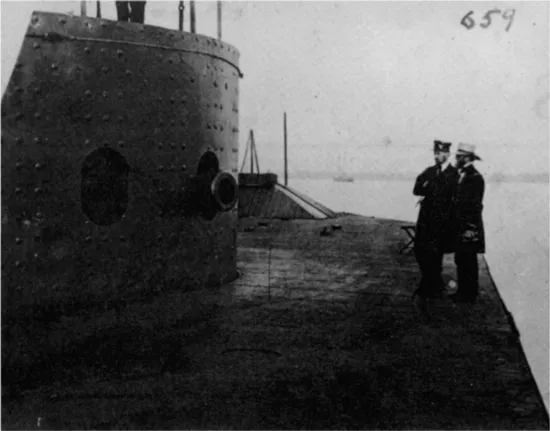![]()
Part I
United States Navy Warships
![]()
1
Armored Vessels
By 1861, the first ironclad warships had been developed in France and Britain; the Gloire and Warrior were already afloat. Earlier, Robert L. Stevens had started construction of his giant unnamed ironclad warship, known to history as the Stevens Battery. This revolutionary design was modified from time to time, but the Navy refused further funds to complete this vessel and it was never finished.
The Navy ordered construction of three experimental ironclads of radically different design in 1861. The first of these revolutionized naval warfare. A low-draft ship without superstructure or rigging, it had only a revolving turret on a flush deck and was aptly described as “the cheese box on a raft.” Designed by John Ericsson and named Monitor, it presented a very small target area by eliminating all top-hamper and having an extremely low freeboard. The ship was built extremely quickly being launched within 101 days of the keel being laid.
Following the Monitor’s stunning success in standing off the Confederate Virginia at Hampton Roads in March 1862, the Navy ordered many additional vessels of the Monitor type. The Passaic and Canonicus classes were basically modified repeat Monitors. Ericsson also designed the larger Dictator and the twin-turreted Puritan.
Other twin-turret monitors, Onondaga and the four near-sisters of the Monadnock class, were designed by others. Construction of the larger ocean-going Kalamazoo class was suspended at the end of the war and never resumed, as was the similar sized Puritan. Many of these ships were built with poorly seasoned timber that quickly deteriorated.
The Puritan and the four Monadnock class ships remained on the Navy List for many years by the subterfuge of “repairing” the old hulls while actually building new ones. As appropriations did not cover the cost of new monitors, old ships were turned over to the contractors as payment.
Not all the monitor designs were successful. A need for low-draft monitors for river operations led to the disastrous Casco class of twenty ships. Because of poor planning and erroneous calculations, they floated with their decks barely above water before being fitted with turrets and other heavy gear. Although a few served as torpedo boats without turrets, most were never used and all were scrapped within about ten years.
The second experimental ironclad ordered in 1861, the New Ironsides, was a more conventional armored broadside vessel. Speed was not considered important for the ship, but she suffered practically no damage from enemy fire although hit numerous times. The third vessel was the smaller Galena, whose armor proved inadequate against shore batteries; she was quickly converted to an unarmored corvette.
Another curious vessel produced at this time was the Keokuk, whose defense against shellfire was so poor that she sank the day after her first day under fire. The monster ironclad ram Dun-derberg, a broadside vessel similar in design to the Confederate ironclads, was so delayed in construction that she was rejected by the Navy in 1865 and eventually sold to France. The screw frigate Roanoke was cut down to the gun deck, armored, and three turrets were mounted on the low hull. The conversion was not successful because the weight of the turrets was too great for the wooden hull.
Fig 1.1 Monitors laid up at Washington Navy Yard, 1866. The ship in the center is either Casco or Chimo completed without a turret. Right to left behind her are Montauk, Saugus and Mahopac which retain their Civil War distinguishing markings. (U.S. Naval Historical Center)
Fig 1.2 A closeup view of the Monitor’s turret, 1862, looking forward. Some dents from her battle are visible in the turret. (U.S. Naval Historical Center)
Of all the ne...


